Snow Impurities in the Central Pyrenees: From Their Geochemical and Mineralogical Composition towards Their Impacts on Snow Albedo
Abstract
:1. Introduction
2. Experiments
2.1. Study Area and Period
2.2. Sample Collection
2.3. Analytical Determinations
2.4. Mineralogy of African Dust Samples
2.5. Distributed Snow Albedo Observations
2.6. Snow Depth, Temperature, Precipitation, and Albedo in Izas Catchment
3. Results
3.1. Atmospheric Deposition: Seasonal Variations and Geochemical and Mineralogical Composition
3.1.1. Aerosol Fluxes and Seasonal Variations: Impact of African Dust
3.1.2. Geochemical Composition of Insoluble Particles
3.1.3. Mineralogical Composition of African Dust
3.2. Impact on Snow Albedo
4. Discussion
5. Conclusions
Author Contributions
Funding
Acknowledgments
Conflicts of Interest
Data Availability
References
- Pöschl, U. Atmospheric aerosols: Composition, transformation, climate and health effects. Angew. Chem. Int. Ed. Engl. 2005, 44, 7520–7540. [Google Scholar] [CrossRef] [PubMed]
- Pope, C.A., III; Dockery, D.W. Health Effects of Fine Particulate Air Pollution: Lines that Connect. J. Air Waste Manag. Assoc. 2006, 56, 709–742. [Google Scholar] [CrossRef]
- Mahowald, N. Aerosol indirect effect on biogeochemical cycles and climate. Science 2011, 334, 794–796. [Google Scholar] [CrossRef] [PubMed]
- Camarero, L.; Catalan, J. Atmospheric phosphorus deposition may cause lakes to revert from phosphorus limitation back to nitrogen limitation. Nat. Commun. 2012, 3, 1118. [Google Scholar] [CrossRef] [PubMed] [Green Version]
- Bond, T.C.; Doherty, S.J.; Fahey, D.W.; Forster, P.M.; Berntsen, T.; DeAngelo, B.J.; Flanner, M.G.; Ghan, S.; Kärcher, B.; Koch, D.; et al. Bounding the role of black carbon in the climate system: A scientific assessment. J. Geophys. Res. Atmos. 2013, 118, 5380–5552. [Google Scholar] [CrossRef]
- IPCC. Intergovernmental Panel on Climate Change: Working Group I Contribution to the IPCC Fifth Assessment Report Climate Change 2013: The Physical Science Basis; IPCC Cambridge University Press: Cambridge, UK; New York, NY, USA, 2013; p. 1535.
- Hadley, O.; Kirchstetter, T. Black-carbon reduction of snow albedo. Nat. Clim. Chang. 2012, 2, 437–440. [Google Scholar] [CrossRef]
- Qu, B.; Ming, J.; Kang, S.-C.; Zhang, G.-S.; Li, Y.-W.; Li, C.-D.; Zhao, S.-Y.; Ji, Z.-M.; Cao, J.-J. The decreasing albedo of the Zhadang glacier on western Nyainqentanglha and the role of light-absorbing impurities. Atmos. Chem. Phys. 2014, 14, 11117–11128. [Google Scholar] [CrossRef] [Green Version]
- Shi, T.; Pu, W.; Zhou, Y.; Cui, J.; Zhang, D.; Wang, X. Albedo of black carbon-contaminated snow across northwestern China and the validation with model simulation. J. Geophys. Res. Atmos. 2020, 125, e2019JD032065. [Google Scholar] [CrossRef]
- Painter, T.H.; Bryant, A.C.; Skiles, S.M. Radiative forcing by light absorbing impurities in snow from MODIS surface reflectance data. Geophys. Res. Lett. 2012, 39, L17502. [Google Scholar] [CrossRef]
- Di Mauro, B.; Fava, F.; Ferrero, L.; Garzonio, R.; Baccolo, G.; Delmonte, B.; Colombo, R. Mineral dust impact on snow radiative properties in the European Alps combining ground, UAV, and satellite observations. J. Geophys. Res. Atmos. 2015, 120, 6080–6097. [Google Scholar] [CrossRef]
- Skiles, S.M.; Flanner, M.; Cook, J.M.; Dumont, M.; Painter, T.H. Radiative forcing by light-absorbing particles in snow. Nat. Clim. Chang. 2018, 8, 964–971. [Google Scholar] [CrossRef]
- Painter, T.H.; Barrett, A.P.; Landry, C.C.; Neff, J.C.; Cassidy, M.P.; Lawrence, C.R.; McBride, K.E.; Farmer, G.L. Impact of disturbed desert soils on duration of mountain snow cover. Geophys. Res. Lett. 2007, 34, L12502. [Google Scholar] [CrossRef] [Green Version]
- Painter, T.H.; Deems, J.S.; Belnap, J.; Hamlet, A.F.; Landry, C.C.; Udall, B. Response of Colorado River runoff to dust radiative forcing in snow. Proc. Natl. Acad. Sci. USA 2010, 107, 17125–17130. [Google Scholar] [CrossRef] [PubMed] [Green Version]
- Skiles, S.; Painter, T. Daily evolution in dust and black carbon content, snow grain size, and snow albedo during snowmelt, Rocky Mountains, Colorado. J. Glaciol. 2017, 63, 118–132. [Google Scholar] [CrossRef] [Green Version]
- Tuzet, F.; Dumont, M.; Picard, G.; Lamare, M.; Voisin, D.; Nabat, P.; Lafaysse, M.; Larue, F.; Revuelto, J.; Arnaud, L. Quantification of the radiative impact of light-absorbing particles during two contrasted snow seasons at Col du Lautaret (2058 m a.s.l., French Alps). Cryosphere Discuss 2020, 1–38. [Google Scholar] [CrossRef] [Green Version]
- Usha, K.H.; Nair, V.S.; Babu, S.S. Modeling of aerosol induced snow albedo feedbacks over the Himalayas and its implications on regional climate. Clim. Dyn. 2020, 54, 4191–4210. [Google Scholar] [CrossRef]
- Pere, J.C.; Colette, A.; Dubuisson, P.; Bessagnet, B.; Mallet, M.; Pont, V. Impacts of future air pollution mitigation strategies on the aerosol direct radiative forcing over Europe. Atmos. Environ. 2012, 62, 451–460. [Google Scholar] [CrossRef]
- Koch, D.; Bauer, S.E.; Del Genio, A.; Faluvegi, G.; McConnell, J.R.; Menon, S.; Miller, R.L.; Rind, D.; Ruedy, R.; Schmidt, G.A.; et al. Coupled aerosol-chemistry–climate twentieth-century transient model investigation: Trends in short-lived species and climate responses. J. Clim. 2011, 24, 2693–2714. [Google Scholar] [CrossRef]
- Krishnan, S.; Ekman, A.M.; Hansson, H.C.; Riipinen, I.; Lewinschal, A.; Wilcox, L.J.; Dallafior, T. The roles of the atmosphere and ocean in driving Arctic warming due to European aerosol reductions. Geophys. Res. Lett. 2020, 47, e2019GL086681. [Google Scholar] [CrossRef] [Green Version]
- López-Moreno, J.I.; García-Ruiz, J.M. Influence of snow accumulation and snowmelt on streamflow in the central Spanish Pyrenees/Influence de l’accumulation et de la fonte de la neige sur les écoulements dans les Pyrénées centrales espagnoles. Hydrolog. Sci. J. 2004, 49, 802. [Google Scholar] [CrossRef]
- Querol, X.; Pey, J.; Pandolfi, M.; Alastuey, A.; Cusack, M.; Moreno, T.; Viana, M.; Mihalopoulos, N.; Kallos, G.; Kleanthous, S. African dust contributions to mean ambient PM10 levels across the Mediterranean Basin. Atmos. Environ. 2009, 43, 4266–4277. [Google Scholar] [CrossRef]
- Pey, J.; Querol, X.; Alastuey, A.; Forastiere, F.; Stafoggia, M. African dust outbreaks over the Mediterranean Basin during 2001–2011: PM10 concentrations, phenomenology and trends, and its relation with synoptic and mesoscale meteorology. Atmos. Chem. Phys. 2013, 13, 1395–1410. [Google Scholar] [CrossRef] [Green Version]
- Àvila, A.; Rodà, F. Red rains as major contributors of nutrients and alkalinity to terrestrial ecosystems at Montseny (NE Spain). Orsis 1999, 6, 215–229. [Google Scholar]
- Cáliz, J.; Triadó-Margarit, X.; Camarero, L.; Casamayor, E.O. A long-term survey unveils strong seasonal patterns in the airborne microbiome coupled to general and regional atmospheric circulations. Proc. Natl. Acad. Sci. USA 2018, 115, 12229–12234. [Google Scholar] [CrossRef] [Green Version]
- Stafoggia, M.; Zauli-Sajani, S.; Pey, J.; Samoli, E.; Alessandrini, E.; Stafoggia, M.; Zauli-Sajani, S.; Pey, J.; Samoli, E.; Alessandrini, E.; et al. Desert Dust outbreaks in southern europe: contribution to daily pm10 concentrations and short-term associations with mortality and hospital admissions. Environ. Health Perspect. 2016, 124, 413–419. [Google Scholar] [CrossRef] [Green Version]
- Àvila, A.; Peñuelas, J. Increasing frequency of Saharan rains over northeastern Spain and its ecological consequences. Sci. Total Environ. 1999, 228, 153–156. [Google Scholar] [CrossRef]
- Markaki, Z.; Oikonomou, K.; Koçak, M.; Kouvrakis, G.; Chaniotaki, A.; Kubilay, N.; Mihalopoulos, N. Atmospheric deposition of inorganic phosphorus in the Levantine Basin, Eastern Mediterranean: Spatial and temporal variability and its role in seawater productivity. Limnol. Oceanogr. 2003, 48, 1557–1568. [Google Scholar] [CrossRef] [Green Version]
- Pey, J.; Larrasoaña, J.C.; Pérez, N.; Cerro, J.C.; Castillo, S.; Tobar, M.L.; de Vergara, A.; Vázquez, I.; Reyes, J.; Mata, M.P.; et al. Phenomenology and geographical gradients of atmospheric deposition in southwestern Europe: Results from a multi-site monitoring network. Sci. Total Environ. 2020, 140745, in press. [Google Scholar] [CrossRef]
- Revuelto, J.; Azorin-Molina, C.; Alonso-González, E.; Sanmiguel-Vallelado, A.; Navarro-Serrano, F.; Rico, I.; López-Moreno, J.I. Meteorological and snow distribution data in the Izas Experimental Catchment (Spanish Pyrenees) from 2011 to 2017. Earth Syst. Sci. Data 2017, 9, 993–1005. [Google Scholar] [CrossRef] [Green Version]
- Querol, X.; Pey, J.; Minguillón, M.C.; Pérez, N.; Alastuey, A.; Viana, M.; Moreno, T.; Bernabé, R.M.; Blanco, S.; Cárdenas, B.; et al. PM speciation and sources in Mexico during the MILAGRO-2006 Campaign. Atmos. Chem. Phys. 2018, 8, 111–128. [Google Scholar] [CrossRef] [Green Version]
- Alastuey, A.; Querol, X.; Aas, W.; Lucarelli, F.; Pérez, N.; Moreno, T.; Cavalli, F.; Areskoug, H.; Balan, V.; Catrambone, M.; et al. Geochemistry of PM10 over Europe during the EMEP intensive measurement periods in summer 2012 and winter 2013. Atmos. Chem. Phys. 2016, 16, 6107–6129. [Google Scholar] [CrossRef] [Green Version]
- Cavalli, F.; Viana, M.; Yttri, K.E.; Genberg, J.; Putaud, J.-P. Toward a standardised thermal-optical protocol for measuring atmospheric organic and elemental carbon: The EUSAAR protocol. Atmos. Meas. Tech. 2010, 3, 79–89. [Google Scholar] [CrossRef] [Green Version]
- Cerro, J.C.; Cerdà, V.; Querol, X.; Alastuey, A.; Bujosa, C.; Pey, J. Variability of air pollutants, and PM composition and sources at a regional background site in the Balearic Islands: Review of western Mediterranean phenomenology from a 3-year study. Sci. Total Environ. 2020, 717, 137177. [Google Scholar] [CrossRef] [PubMed]
- The Powder Diffraction File. International Centre for Diffraction Data. Available online: https://www.icdd.com/pdf-2/ (accessed on 1 September 2020).
- Kipp & Zonen, B.V. CMP/CMA Series Pyranometer and Albedometer, Instruction Manual; Copyright©2016 Kipp & Zonen B.V.: Delft, The Netherlands, 2016. [Google Scholar]
- Picard, G.; Dumont, M.; Lamare, M.; Tuzet, F.; Larue, F.; Pirazzini, R.; Arnaud, L. Spectral albedo measurements over snow-covered slopes: Theory and slope effect corrections. Cryosphere 2020, 14, 1497–1517. [Google Scholar] [CrossRef]
- Scheuvens, D.; Schütz, L.; Kandler, K.; Ebert, M.; Weinbruch, S. Bulk composition of northern African dust and its source sediments—A compilation. Earth Sci. Rev. 2013, 116, 170–194. [Google Scholar] [CrossRef]
- Fu, Y.; Desboeufs, K.; Vincent, J.; Bon Nguyen, E.; Laurent, B.; Losno, R.; Dulac, F. Estimating chemical composition of atmospheric deposition fluxes from mineral insoluble particles deposition collected in the western Mediterranean region. Atmos. Meas. Tech. 2017, 10, 4389–4401. [Google Scholar] [CrossRef] [Green Version]
- Escudero, M.; Castillo, S.; Querol, X.; Avila, A.; Alarcón, M.; Viana, M.M.; Alastuey, A.; Cuevas, E.; Rodríguez, S. Wet and dry African dust episodes over eastern Spain. J. Geophys. Res. 2005, 110, D18S08. [Google Scholar] [CrossRef] [Green Version]
- Salvador, P.; Alonso-Pérez, S.; Pey, J.; Artíñano, B.; de Bustos, J.J.; Alastuey, A.; Querol, X. African dust outbreaks over the western Mediterranean Basin: 11-year characterization of atmospheric circulation patterns and dust source areas. Atmos. Chem. Phys. 2014, 14, 6759–6775. [Google Scholar] [CrossRef] [Green Version]
- Moreno, T.; Querol, X.; Castillo, S.; Alastuey, A.; Cuevas, E.; Herrmann, L.; Mounkaila, M.; Elvira, J.; Gibbons, W. Geochemical variations in aeolian mineral particles from the Sahara–Sahel Dust Corridor. Chemosphere 2006, 65, 261–270. [Google Scholar] [CrossRef]
- Wu, G.; Xu, T.; Zhang, X.; Zhang, C.; Yan, N. The visible spectroscopy of iron oxide minerals in dust particles from ice cores on the Tibetan Plateau. Tellus B Chem. Phys. Meteorol. 2016, 68, 29191. [Google Scholar] [CrossRef] [Green Version]
- Moulin, C.; Lambert, C.E.; Dulac, F.; Dayan, U. Control of atmospheric export of dust from North Africa by the North At-lantic Oscillation. Nature 1997, 387, 691–694. [Google Scholar] [CrossRef]
- Jerez, S.; Jimenez-Guerrero, P.; Montávez, J.P.; Trigo, R.M. Impact of the North Atlantic Oscillation on European aerosol ground levels through local processes: A seasonal model-based assessment using fixed anthropogenic emissions. Atmos. Chem. Phys. 2013, 13, 11195–11207. [Google Scholar] [CrossRef] [Green Version]
- Desboeufs, K.; Bon Nguyen, E.; Chevaillier, S.; Triquet, S.; Dulac, F. Fluxes and sources of nutrient and trace metal atmospheric deposition in the northwestern Mediterranean. Atmos. Chem. Phys. 2018, 18, 14477–14492. [Google Scholar] [CrossRef] [Green Version]
- Vincent, J.; Laurent, B.; Losno, R.; Bon Nguyen, E.; Roullet, P.; Sauvage, S.; Chevaillier, S.; Coddeville, P.; Ouboulmane, N.; di Sarra, A.G.; et al. Variability of mineral dust deposition in the western Mediterranean basin and south-east of France. Atmos. Chem. Phys. 2016, 16, 8749–8766. [Google Scholar] [CrossRef] [Green Version]
- Dumont, M.; Brun, E.; Picard, G.; Michou, M.; Libois, Q.; Petit, J.-R.; Geyer, M.; Morin, S.; Josse, B. Contribution of light-absorbing impurities in snow to Greenland’s darkening since 2009. Nat. Geosci. 2014, 7, 509–512. [Google Scholar] [CrossRef]
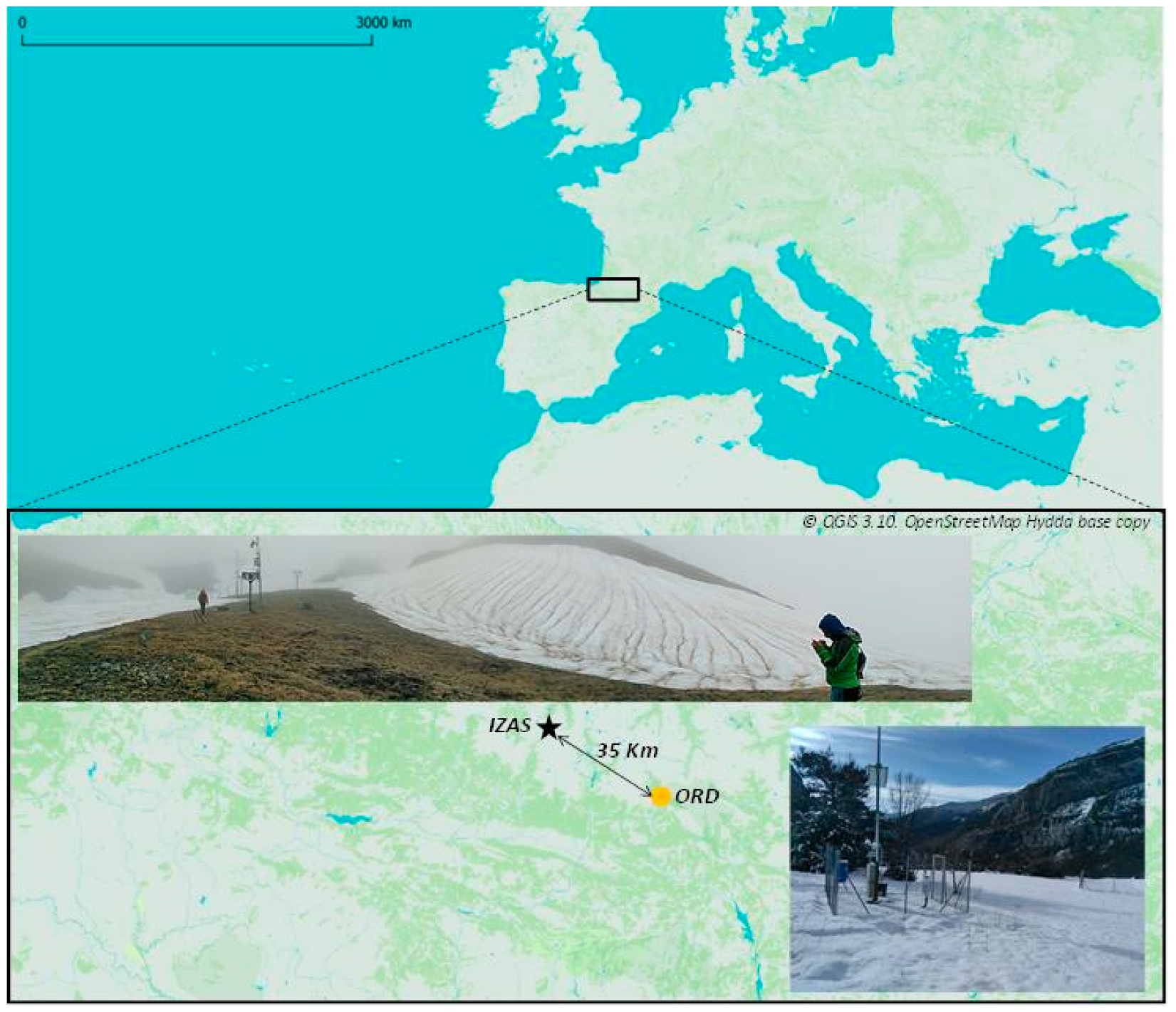
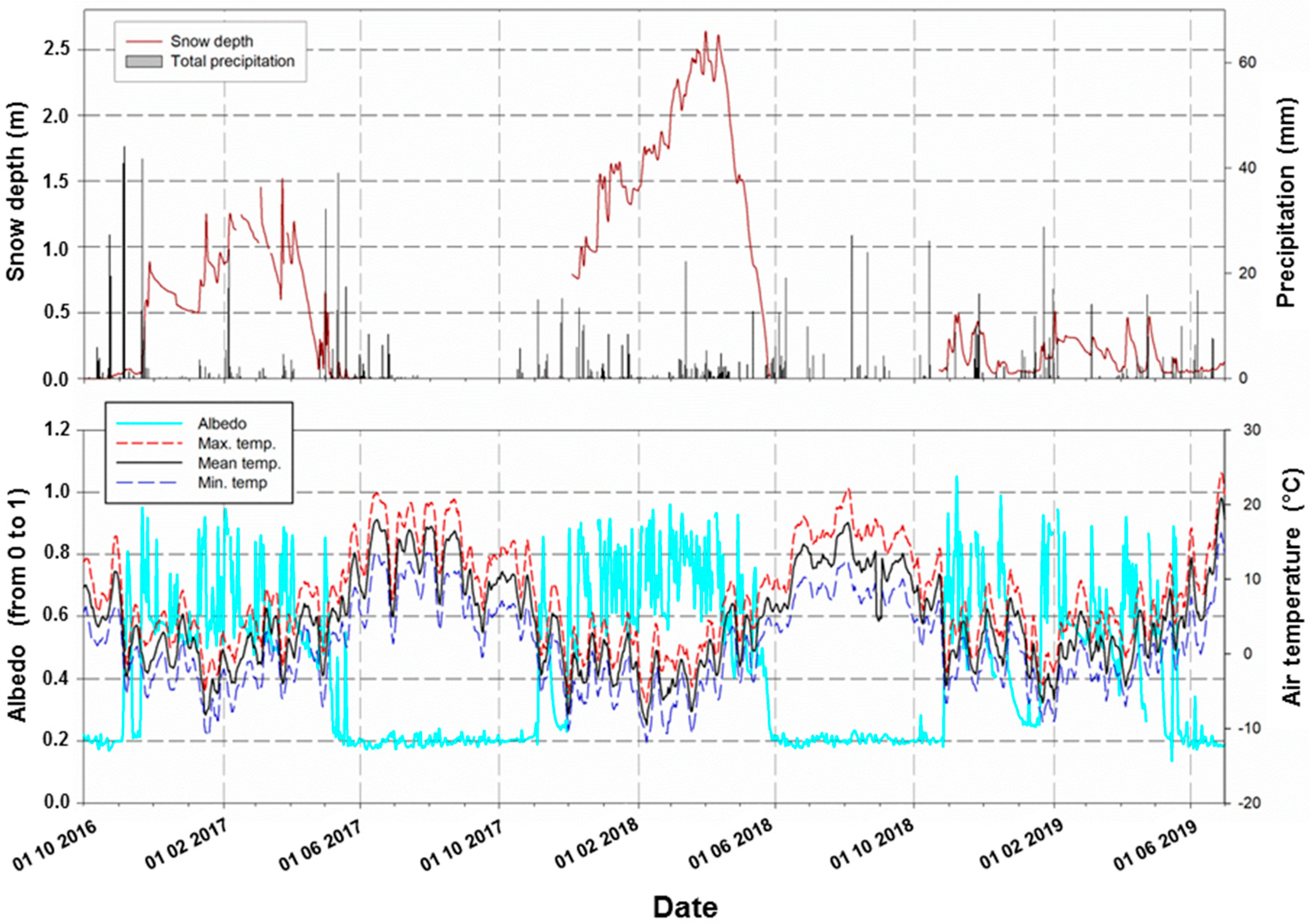
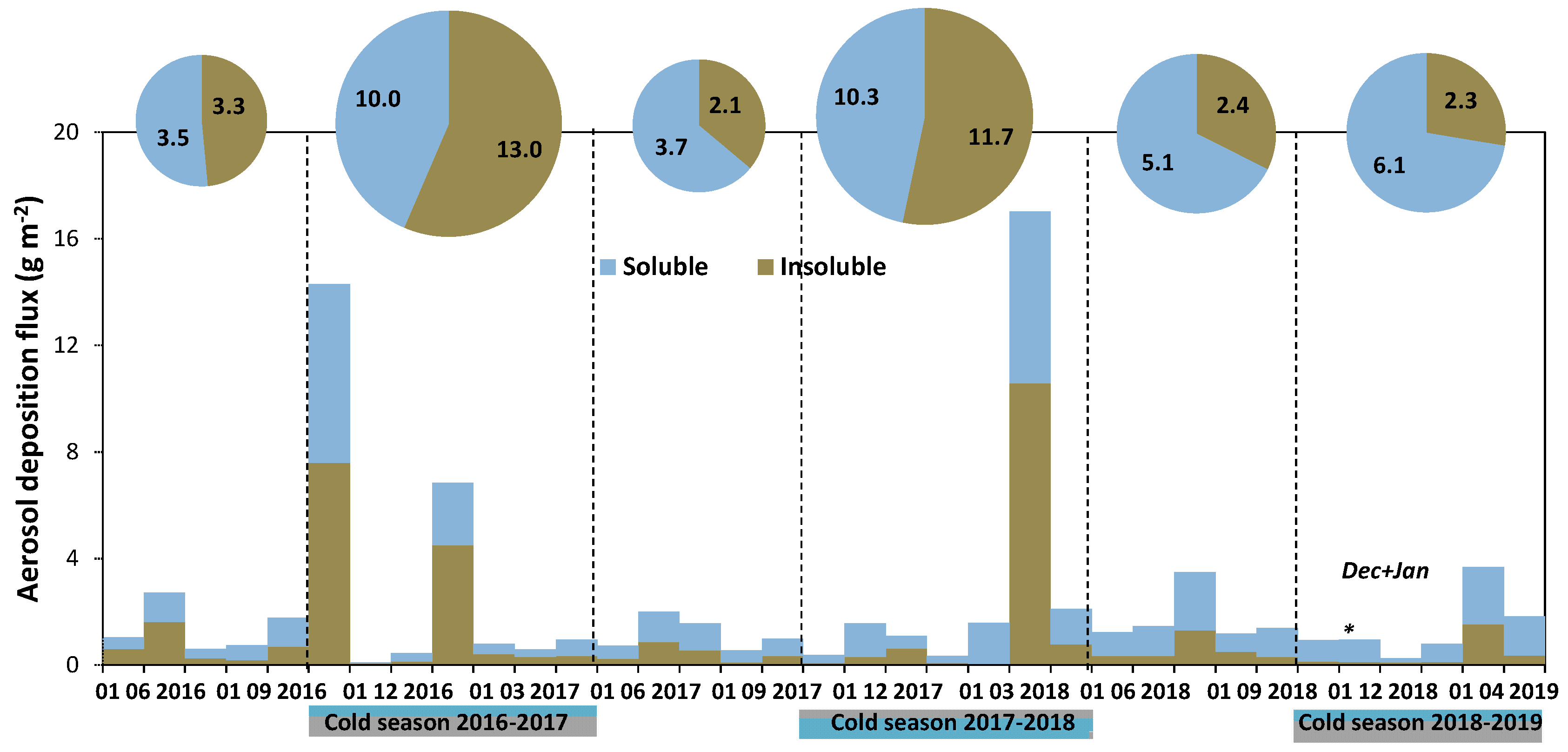

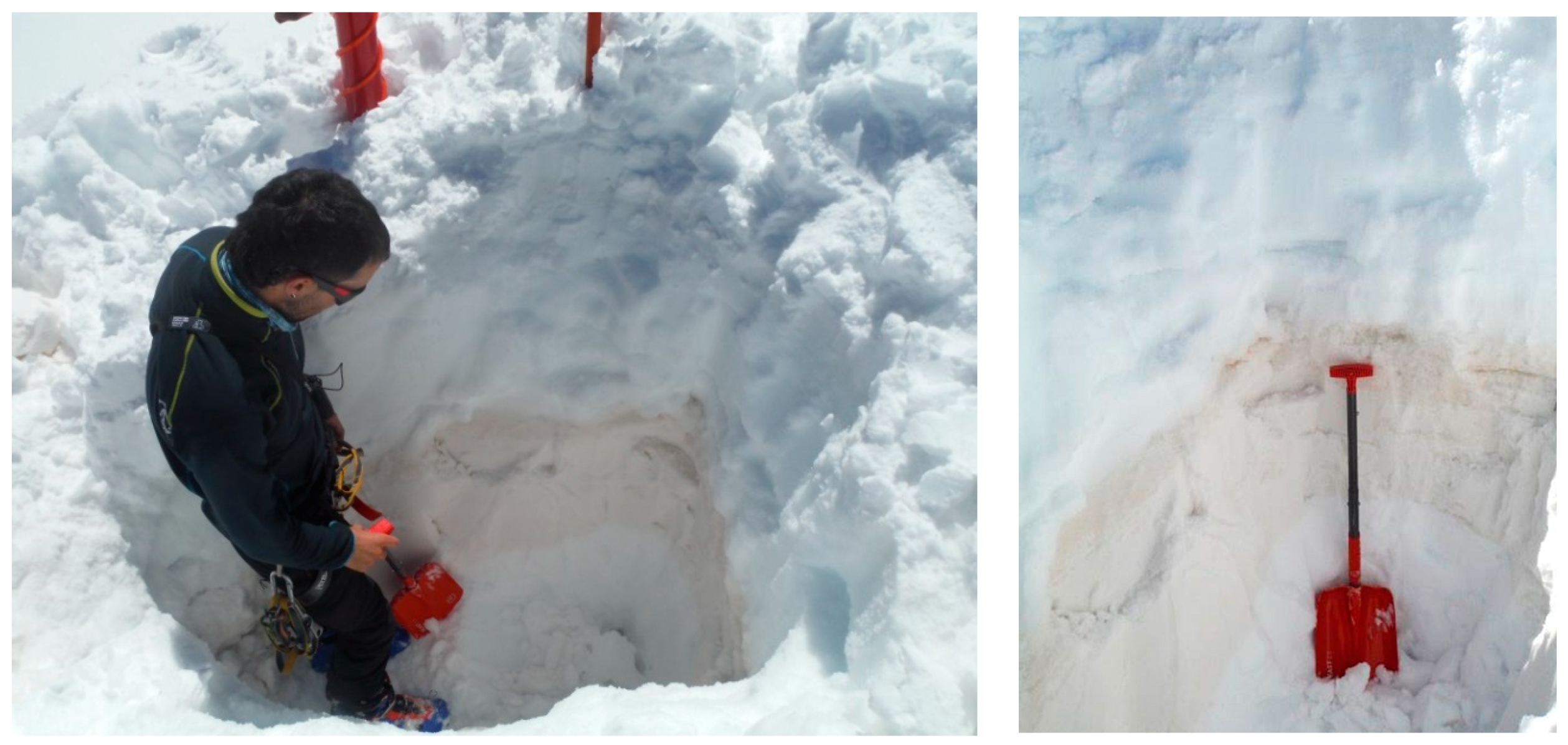
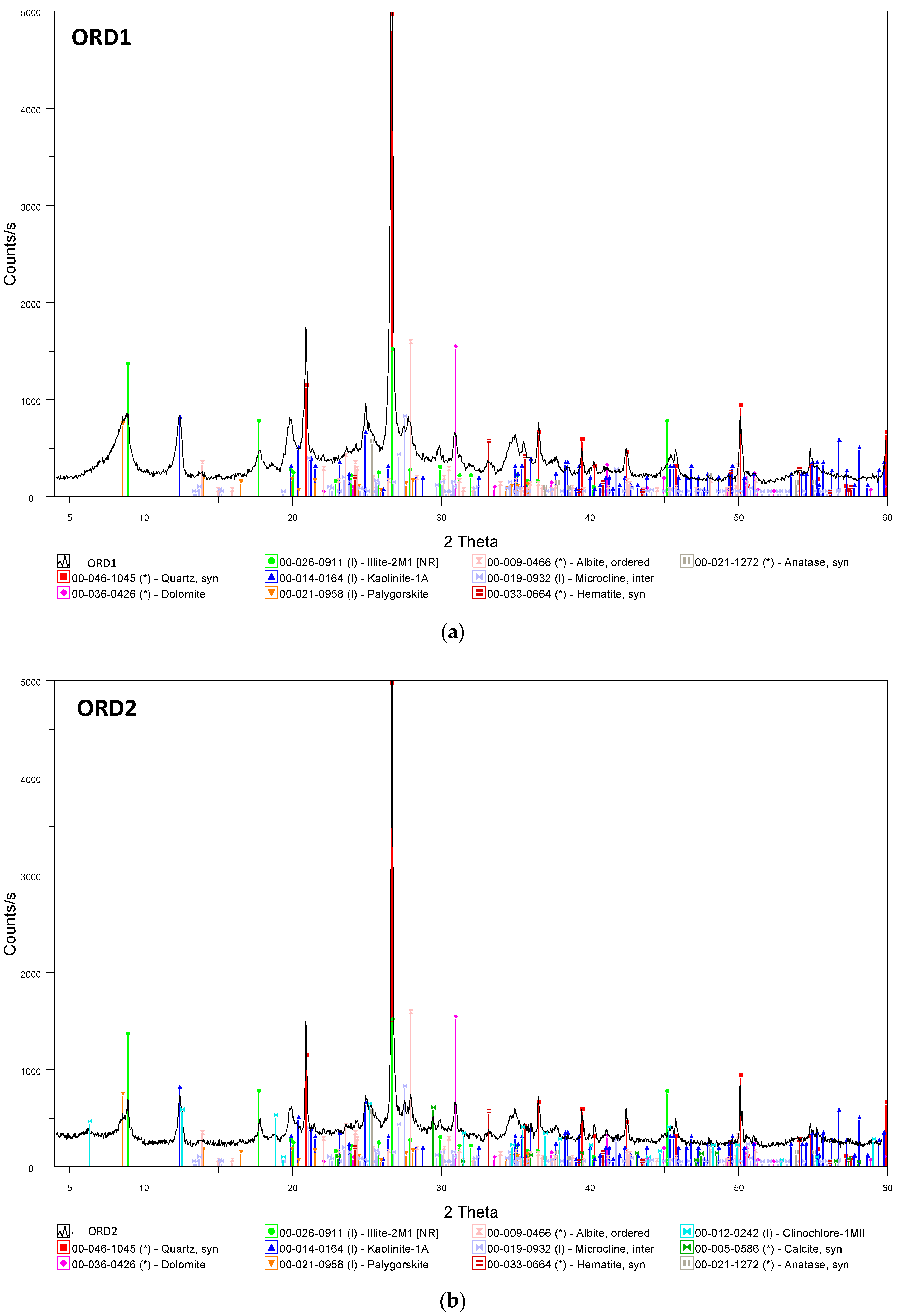
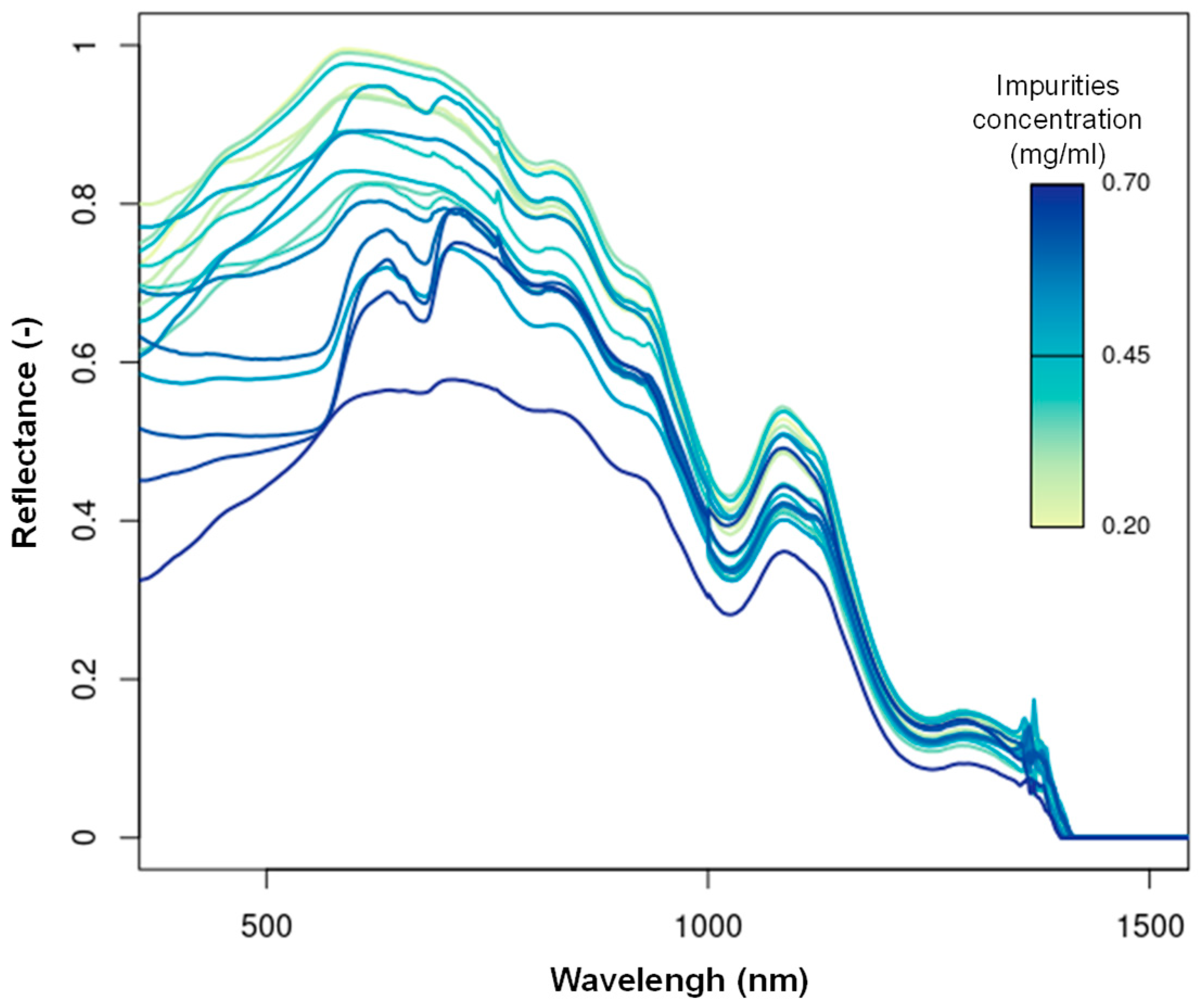
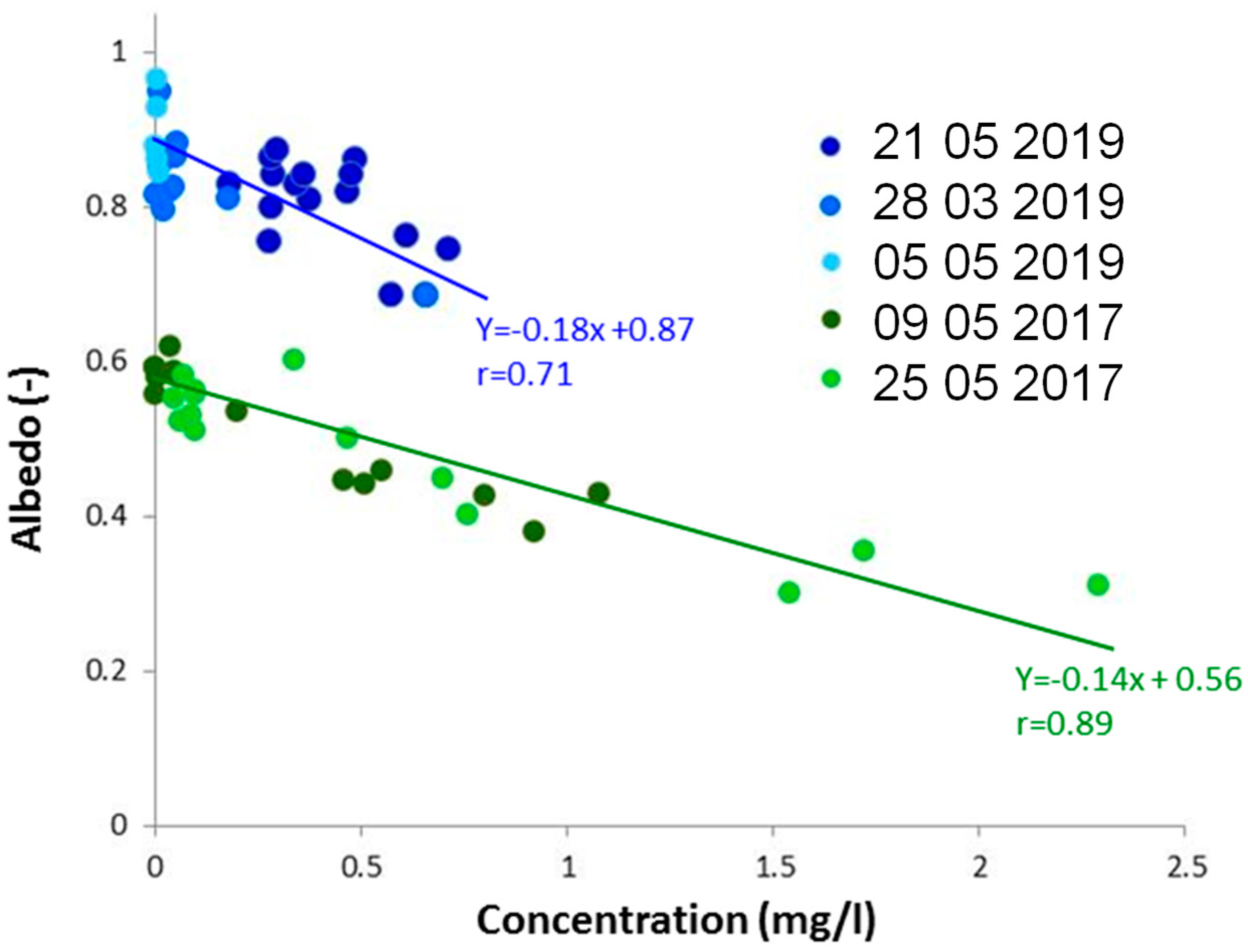
| Major and Trace Chemicals | Snow Dust Samples | 15-Days Atmospheric Deposition | Ratio Atmospheric Deposition Snow Dust Samples | ||||
|---|---|---|---|---|---|---|---|
| SDS1 | SDS2 | ORD1 | ORD2 | ORD1/SDS1 | ORD2/SDS2 | ||
| mg m−2 | SiO2 | 2651 | 1597 | 3160 | 1952 | 1.2 | 1.2 |
| Al2O3 | 1060 | 639 | 1264 | 781 | 1.2 | 1.2 | |
| CaO | 594 | 289 | 144 | 97 | 0.2 | 0.3 | |
| Fe2O3 | 1019 | 592 | 1030 | 624 | 1.0 | 1.1 | |
| K2O | 248 | 149 | 427 | 233 | 1.7 | 1.6 | |
| MgO | 337 | 216 | 273 | 172 | 0.8 | 0.8 | |
| Na2O | 176 | 119 | 87 | 47 | 0.5 | 0.4 | |
| TiO2 | 56 | 37 | 27 | 13 | 0.5 | 0.4 | |
| MnO | 8 | 5 | 8 | 5 | 0.9 | 1.1 | |
| µg m−2 | Sr | 978 | 583 | 832 | 528 | 0.9 | 0.9 |
| Be | 18 | 11 | 21 | 9 | 1.1 | 0.8 | |
| V | 839 | 522 | 894 | 446 | 1.1 | 0.9 | |
| Cr | 695 | 409 | 733 | 345 | 1.1 | 0.8 | |
| Co | 139 | 80 | 138 | 24 | 1.0 | 0.3 | |
| Ni | 370 | 211 | 371 | 177 | 1.0 | 0.8 | |
| Cu | 280 | 163 | 338 | 147 | 1.2 | 0.9 | |
| Zn | 1368 | 1753 | 7666 | 2588 | 5.6 | 1.5 | |
| As | 79 | 50 | 87 | 42 | 1.1 | 0.8 | |
| Se | 40 | 20 | 61 | 47 | 1.5 | 2.3 | |
| Cd | 18 | 2 | 8 | 10 | 0.4 | 6.8 | |
| Sb | 12 | 5 | 14 | 6 | 1.2 | 1.2 | |
| Ba | 3769 | 2420 | 3658 | 2180 | 1.0 | 0.9 | |
| Pb | 252 | 154 | 314 | 174 | 1.2 | 1.1 | |
| Th | 114 | 60 | 109 | 59 | 1.0 | 1.0 | |
| U | 16 | 11 | 19 | 10 | 1.2 | 0.9 | |
| Mineral dust (g m−2) | 6.16 | 3.65 | 6.43 | 3.93 | 1.0 | 1.1 | |
© 2020 by the authors. Licensee MDPI, Basel, Switzerland. This article is an open access article distributed under the terms and conditions of the Creative Commons Attribution (CC BY) license (http://creativecommons.org/licenses/by/4.0/).
Share and Cite
Pey, J.; Revuelto, J.; Moreno, N.; Alonso-González, E.; Bartolomé, M.; Reyes, J.; Gascoin, S.; López-Moreno, J.I. Snow Impurities in the Central Pyrenees: From Their Geochemical and Mineralogical Composition towards Their Impacts on Snow Albedo. Atmosphere 2020, 11, 937. https://doi.org/10.3390/atmos11090937
Pey J, Revuelto J, Moreno N, Alonso-González E, Bartolomé M, Reyes J, Gascoin S, López-Moreno JI. Snow Impurities in the Central Pyrenees: From Their Geochemical and Mineralogical Composition towards Their Impacts on Snow Albedo. Atmosphere. 2020; 11(9):937. https://doi.org/10.3390/atmos11090937
Chicago/Turabian StylePey, Jorge, Jesús Revuelto, Natalia Moreno, Esteban Alonso-González, Miguel Bartolomé, Jesús Reyes, Simon Gascoin, and Juan Ignacio López-Moreno. 2020. "Snow Impurities in the Central Pyrenees: From Their Geochemical and Mineralogical Composition towards Their Impacts on Snow Albedo" Atmosphere 11, no. 9: 937. https://doi.org/10.3390/atmos11090937
APA StylePey, J., Revuelto, J., Moreno, N., Alonso-González, E., Bartolomé, M., Reyes, J., Gascoin, S., & López-Moreno, J. I. (2020). Snow Impurities in the Central Pyrenees: From Their Geochemical and Mineralogical Composition towards Their Impacts on Snow Albedo. Atmosphere, 11(9), 937. https://doi.org/10.3390/atmos11090937








